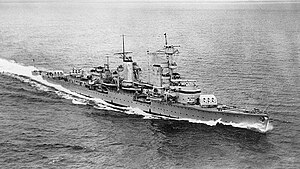German cruiser Köln
 |
|
| History | |
|---|---|
|
|
|
| Name: | Köln |
| Launched: | 23 May 1928 |
| Commissioned: | January 1930 |
| Fate: | Sunk by American aircraft on 3 March 1945 |
| General characteristics | |
| Class and type: | Königsberg-class cruiser |
| Displacement: | 7,700 long tons (7,800 t) |
| Length: | 174 m (571 ft) |
| Beam: | 15.3 m (50 ft) |
| Draft: | 6.28 m (20.6 ft) |
| Propulsion: | 3 shafts, two MAN 10-cylinder diesels, four geared turbines |
| Speed: | 32 knots (59 km/h; 37 mph) |
| Range: | 5,700 nmi (10,600 km; 6,600 mi) at 19 knots (35 km/h; 22 mph) |
| Complement: |
|
| Armament: |
|
| Armor: |
|
Köln was a light cruiser, the third member of the Königsberg class that was operated between 1929 and March 1945, including service in World War II. She was operated by two German navies, the Reichsmarine and the Kriegsmarine. She had two sister ships, Königsberg and Karlsruhe. Köln was built by the Deutsche Werke shipyard in Kiel; she was laid down in August 1926, launched in May 1928, and commissioned into the Reichsmarine in January 1930. She was armed with a main battery of nine 15 cm SK C/25 guns in three triple turrets and had a top speed of 32 knots (59 km/h; 37 mph).
Like her sister ships, Köln served as a training ship for naval cadets in the 1930s, and joined the non-intervention patrols during the Spanish Civil War during the latter part of the decade. After the outbreak of World War II in September 1939, she conducted several operations in the North Sea, but did not encounter any British warships. She participated in the attack on Bergen during Operation Weserübung in April 1940, and she was the only member of her class to survive the operation. In 1942, she was modified to carry a Flettner Fl 282 helicopter experimentally. Later in 1942, she returned to Norway, but did not see significant action. She remained there until early 1945, when she returned to Germany; in March, she was sunk by American bombers in Wilhelmshaven. She remained on an even keel, with her gun turrets above water; this allowed her to provide gunfire support to defenders of the city until the end of the war in May 1945.
...
Wikipedia
